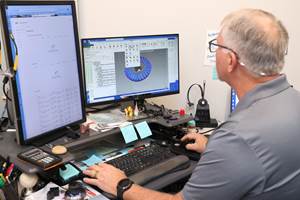Balanced Machining Is Faster Machining
NC program optimization software initially helped Bell Helicopter’s Drive Systems Center machine titanium faster by balancing cutting forces. The manufacturer now uses it to improve cycle times for aircraft parts made from other metals, too.
Share






Bell Helicopter’s Drive Systems Center (DSC) machines more steel than titanium for the aircraft transmission and gearbox assemblies it manufactures. However, a tricky titanium component prompted Bell’s DSC to investigate whether NC program optimization technology would shorten cycle times and unlock capacity on existing equipment as it did for fellow Textron subsidiary, Cessna. Bell’s goal was to reduce manufacturing time, thereby lowering overall costs to its customers.
DSC, located in Grand Prairie, Texas,knew about Cessna’s successes optimizing a number of its part programs using machining process modeling software from Third Wave Systems. Chris Mueninghoff, NC programming supervisor at DSC, says a titanium forging for a commercial application proved to be the ideal test part for Third Wave Systems’ AdvantEdge Production Module software. That’s because the part is one of the most challenging ones Bell machines. Nearly 30 percent of the titanium forging has to be machined away to complete the part, representing more material removal than most other components at Bell. The carrier measures 16 inches in diameter and 6 inches tall.
The Production Module software integrates CAD, CAM, machine dynamics and workpiece material properties as it analyzes machining operations on a given part. As Mr. Mueninghoff explains, the optimization process starts by importing a 3D model of the part and its corresponding machining program. The cutting tools used for each operation are defined by key characteristics such as rake angle, helix angle and tool material. Information about the machine tool and setup is entered, too, including machine horsepower and torque as well as fixture rigidity and cutting force limits. Finally, workpiece material is selected from the software’s database.
The software uses this information to predict the cutting forces tools will experience along their entire tool path. These forces will fluctuate during a cutting operation primarily due to parameters such as feed rate, tool orientation and workpiece material. To optimize each operation, the software compares the calculated force at each line of the original G-code against upper and lower force limits. It then automatically increases or reduces the feed rate accordingly. For example, when force values are well below a defined upper limit, the feed rate is increased to a stable point below the maximum accepted force a tool can experience. This results in not only faster cutting, but also more balanced cutting tool forces. (The graph on the previous page shows typical results of this process balancing for a titanium part.) The software analyzes and generates the modified G-code with new feed rates in 10 to 15 minutes, depending on part complexity, Mr. Mueninghoff says.
Bell validates each modified part program by machining an actual part and sending it through all normal inspection procedures to verify that the modified program will not damage the workpiece, machine tool or cutters. The cycle time for the titanium test part was reduced by 30 percent after process optimization. Since that original test, Bell has used the NC optimization software on approximately 250 components, many made of hardened steel alloys. Most recently, Bell’s NC program optimization efforts have come full-circle to titanium. It refined a program to machine a larger titanium carrier used on the V-22 Osprey tilt-rotor aircraft. These carriers were produced in a two-machine cell. Because Production Module software reduced cycle times for these parts by 25 to 30 percent, however, Bell was able to shift all production to a single machine.
Mr. Mueninghoff says the NC program optimization software has also lead to two other side benefits. One is better cutting tool life and wear resistance. The other is the generation of better overall parts. It’s important to gearbox component designers that Bell limits the amount of fatigue and stress introduced into parts during machining. The optimization software allows Bell to show that it is able to reduce component cycle times without applying techniques that could potentially decrease the life of a key component. In fact, Mr. Mueninghoff notes that DSC is actually putting less stress into the part during machining, ultimately resulting in a higher-quality part.
Related Content
Blueprints to Chips: CAD/CAM Tips and Tricks
This collection of articles delves into the latest CAD/CAM innovations, from AI-driven automation and optimized tool paths to the impact of digital twins and system requirements.
Read MoreHow this Job Shop Grew Capacity Without Expanding Footprint
This shop relies on digital solutions to grow their manufacturing business. With this approach, W.A. Pfeiffer has achieved seamless end-to-end connectivity, shorter lead times and increased throughput.
Read MoreTTI Brings Specialty Gear Production In-House with Multiaxis Machining
By investing in a 3+2-axis machine and utilizing simulation software for diagnostic checks, Techtronic Industries turned a four- to ten-week lead time into a one- to two-week lead time.
Read MoreCutting Part Programming Times Through AI
CAM Assist cuts repetition from part programming — early users say it cuts tribal knowledge and could be a useful tool for training new programmers.
Read MoreRead Next
AMRs Are Moving Into Manufacturing: 4 Considerations for Implementation
AMRs can provide a flexible, easy-to-use automation platform so long as manufacturers choose a suitable task and prepare their facilities.
Read MoreMachine Shop MBA
Making Chips and Modern Machine Shop are teaming up for a new podcast series called Machine Shop MBA—designed to help manufacturers measure their success against the industry’s best. Through the lens of the Top Shops benchmarking program, the series explores the KPIs that set high-performing shops apart, from machine utilization and first-pass yield to employee engagement and revenue per employee.
Read More





















